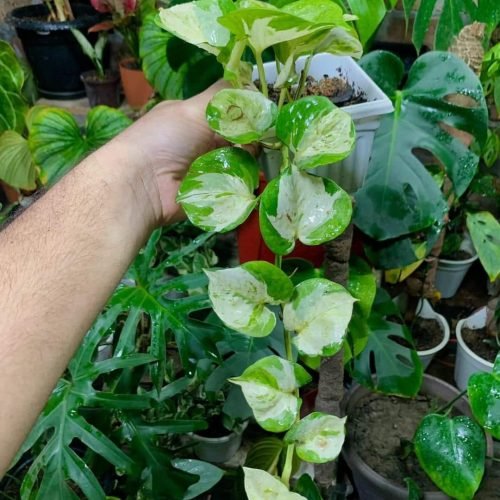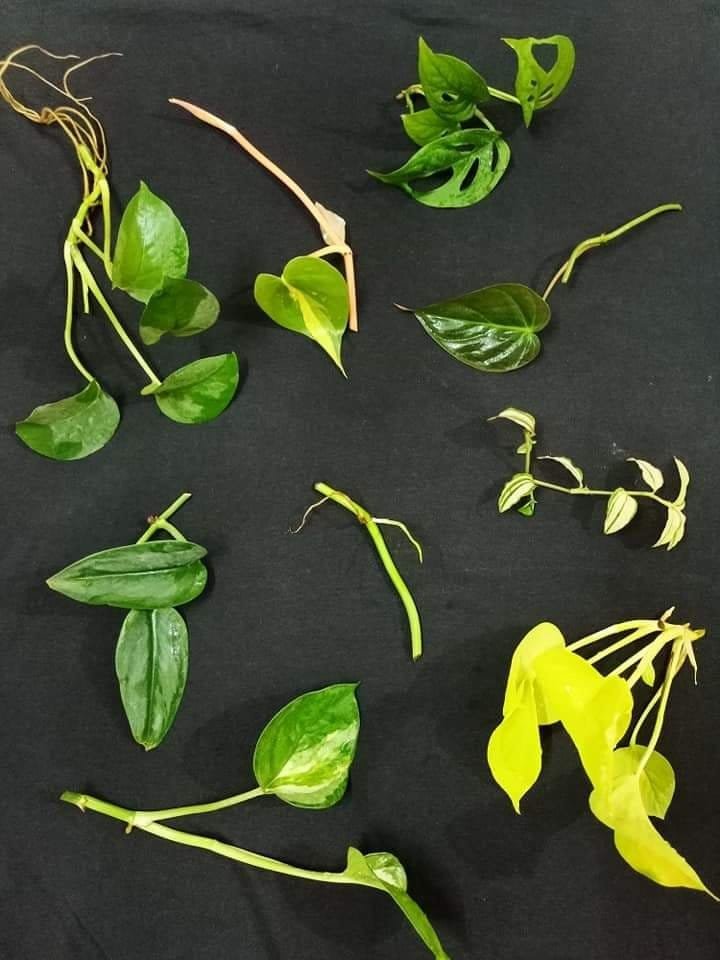
Have you ever looked at your favorite indoor plant and wished you could have more of them without breaking the bank? Well, you’re in luck!
Today, I’m excited to share one of the best-kept secrets in the gardening world: growing plants from cuttings. It’s like plant magic—taking a small piece of a plant and turning it into a whole new one.
When I first started my indoor gardening journey, the idea of propagation seemed daunting. But after a few tries (and some spectacular failures), I discovered that it’s actually a lot of fun and incredibly rewarding.
There’s something truly special about watching a tiny cutting sprout roots and grow into a thriving plant. Plus, it’s a fantastic way to share your green thumb with friends and family. So, grab your scissors, and let’s dive into the world of plant propagation together!
What is Propagation?
Propagation is the process of creating new plants from various sources like seeds, cuttings, and other plant parts. While there are several methods, growing plants from cuttings is particularly popular among indoor gardeners.
It’s a quick, easy, and efficient way to multiply your favorite plants. Plus, it’s a wonderful opportunity to share plants with friends and family. Learn more about indoor plant propagation.
Essential Tools and Materials
Before you dive into propagation, it’s important to gather the right tools and materials. Here’s what you’ll need:
- Sharp scissors or pruning shears: Clean cuts are essential for healthy cuttings.
- Small pots or containers: For planting the cuttings.
- Rooting hormone (optional): Helps speed up the rooting process.
- Water: For plants that root in water.
- Potting soil: A well-draining mix is best for most cuttings.
- Plastic bags or a propagator: To create a humid environment for the cuttings.
Based on my experience, investing in high-quality tools can make a significant difference in your success rate. I personally love my Felco pruning shears (not affiliated) because they make precise cuts without damaging the plant tissue.
The Best Indoor Plants to Grow from Cuttings
Not all plants are created equal when it comes to propagation. Here are some of the easiest indoor plants to grow from cuttings, based on my trials and tribulations:
Pothos (Devil’s Ivy) Pothos is a superstar in the world of propagation. Its cuttings root quickly in water or soil, and it’s incredibly forgiving. Just snip a healthy vine below a node, place it in water or directly into the soil, and watch the magic happen.
Spider Plant Spider plants are not only easy to propagate, but they practically do the work for you. The plantlets, or “babies,” that grow on the mother plant can be snipped off and planted in soil. They root quickly and make perfect gifts for fellow plant enthusiasts.
Snake Plant (Sansevieria) Snake plants, or mother-in-law’s tongue, can be propagated from leaf cuttings. Cut a healthy leaf into sections, let them callus over for a day or two, and then plant them in soil. With a little patience, you’ll have new snake plants to brighten up your home.
Philodendron Philodendrons are another great option for beginners. Simply cut a stem just below a node, place it in water or soil, and watch as roots start to form. They’re fast growers and add a lush, tropical feel to any space.
ZZ Plant (Zamioculcas zamiifolia) ZZ plants are tough, drought-tolerant, and surprisingly easy to propagate. You can use leaf cuttings or stem cuttings. Place the cuttings in water or soil, and in a few weeks, you’ll see new roots starting to develop.
Succulents (e.g., Jade Plant, Echeveria) Succulents are a joy to propagate. Simply take a healthy leaf or stem cutting, let it dry out for a few days to prevent rot, and then place it on top of well-draining soil. Mist lightly until roots form, and soon you’ll have a new succulent ready to thrive.
Herbs (e.g., Basil, Mint) Herbs like basil and mint are some of the easiest plants to propagate. Snip a healthy stem just below a node, place it in water, and within a week or two, roots will start to form. Transfer to soil once the roots are an inch long, and enjoy fresh herbs right at your fingertips.
I am adding a YouTube video below where you will get more plants that you can grow from the cuttings.
Step-by-Step Guide to Propagating Plants from Cuttings
While each plant has its unique needs, the general steps for propagating from cuttings are quite similar. Here’s a step-by-step guide:
- Choose a healthy parent plant: Select a healthy plant with no signs of disease or pests.
- Make the cut: Using sharp, clean scissors, cut a section of the plant just below a node.
- Prepare the cutting: Remove any lower leaves to prevent rot. If you are using rooting hormone, dip the cut end into the powder.
- Plant the cutting: Place the cutting in water or directly into well-draining soil. Make sure that the node is submerged or buried.
- Create a humid environment: Cover the cutting with a plastic bag or place it in a propagator to maintain humidity.
- Wait for roots to develop: This can take anywhere from a few days to several weeks, depending on the plant.
- Transfer to soil (if rooting in water): Once roots are established, transfer the cutting to a small pot with soil.
- Care for your new plant: Keep the soil moist but not waterlogged, and place the plant in bright, indirect light.

Caring for Your New Plants
Once your cuttings have taken root, it’s important to provide the right care to ensure they thrive. Here are some tips:
- Light: Most propagated plants prefer bright, indirect light.
- Water: Keep the soil moist but avoid overwatering. Succulents need less frequent watering.
- Humidity: Maintain a humid environment, especially when it’s a tropical plant.
- Fertilizer: Once the plants are established, feed them with a balanced, water-soluble fertilizer.
I’ve found that keeping a close eye on my new plants and adjusting care as needed has been key to my success. There’s no one-size-fits-all approach, so don’t be afraid to test and find what works best for you.

Troubleshooting Common Problems
Propagation isn’t always smooth sailing. Here are some common issues and how to address them:
- Rotting cuttings: Ensure cuttings aren’t too deep in water or soil and avoid overwatering.
- No roots forming: Be patient and ensure the cutting is healthy and receiving adequate light.
- Wilting cuttings: Check for pests and ensure the cutting is in a humid environment.
I’ve had my share of challenges, but with persistence and care, most issues can be resolved. Don’t get discouraged if things don’t go perfectly at first.
Final Thoughts
Growing indoor plants from cuttings is a rewarding and enjoyable way to expand your plant collection. It’s cost-effective, allows you to share plants with others, and gives you a deeper connection to your green companions.
I hope this guide inspires you to give propagation a try and experience the joy of watching new life sprout from a simple cutting. Below, I am answering some of the common questions asked regarding this.
Frequently Asked Questions
Q: Can I propagate all indoor plants from cuttings?
A: Not all plants are suitable for propagation from cuttings. Some may require different methods like division or air layering. However, many popular indoor plants, such as pothos, philodendrons, and spider plants, are very easy to propagate from cuttings.
Q: How long does it take for cuttings to root?
A: It varies depending on the plant, but most cuttings take a few weeks to a couple of months to develop roots. Factors such as temperature, humidity, and light conditions can also have an impact on the rooting time.
Q: Do I need to use the rooting hormone?
A: While not necessary, rooting hormone can speed up the rooting process and increase success rates, especially for more challenging plants. If you’re propagating easy plants like pothos or spider plants, you can usually skip it.
Q: Can I propagate cuttings in any type of soil?
A: It’s best to use a well-draining potting mix. For succulents, a cactus mix works well, while most other cuttings will thrive in general-purpose potting soil mixed with perlite or sand to improve drainage.
Q: How often should I water my cuttings?
A: Keep the soil moist but not waterlogged. Overwatering can lead to rot, so it’s better to err on the side of less water. For cuttings rooting in water, change the water every few days to keep it fresh.
Q: What if my cuttings aren’t rooting?
A: If your cuttings aren’t rooting, make sure they are healthy and have enough light. You might also try using a rooting hormone. Sometimes, it just takes a little bit more patience. Ensure the cuttings are kept in a humid environment and that they’re not too cold or too hot.
Q: How can I share my propagated plants with others?
A: Propagated plants make wonderful gifts! Once your cuttings are well-established, you can pot them in attractive containers and give them to friends and family. It’s a great way to share your love of plants and spread some greenery.

